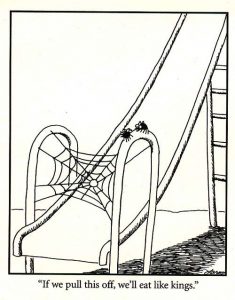We’re in a mundane phase of this project — I’ve got swarms of baby spiders, a handful of wild-caught adults, and I’m waiting for them to reach sexual maturity, so I can start breeding lab lines.
I’ve got a naming convention — the wild-caught adults (Generation 1) all get simple names like Cathy, Barney, Gwyneth, etc. I’ve had a few of them die off already, although I think it was actually murder. It seems that crickets above a certain size are actually able to turn the tables and eat the spider, or at least kill it, and they will definitely consume an egg sac if they stumble on it. I’m learning lessons as I go along — only small crickets. I’m considering trying mealworms as a safer alternative.
For the second generation, each clutch gets named by the first letter of their mother’s name, and the month their egg sac was made. As they reach sexual maturity, they’ll get a letter after the month to distinguish them as individuals. Third generation will get the initials of both parents, but we’re not up to that point yet. I am planning to keep track of the pedigrees of these spiders as I go, in case something unique and interesting crops up.
I do have a sad story. I’ve been particularly watching on individual, GIIXa, Gwyneth’s daughter by an unknown father, laid in August. I’d been calling her Igor, because she had a few deformities — her left foreleg was much longer than her right (it looked like a duplication of one limb segment), and her two hindlegs had limited mobility, so she crawled around dragging her hindlegs, and with her left foreleg raised high up in the air. She made it to near-adulthood, so clearly she was able to capture and eat flies, but today I found that she had died at last. I’d actually be interested in teratological defects, and that I’ve already seen one isn’t too surprising, given how prolific the spiders are.
I’m also pretty sure some of the second generation are reaching sexual maturity, which is about right, since some of them are almost two months old. I’ve got one, AIIXa (a son of Amanda), which already has the massive dark pedipalps that allowed me to recognize him as male — he’ll be losing his virginity soon. I don’t want to give him to one of the first generation females, since they’re so much bigger they might just eat him, but am waiting to be confident that one of the second generation females is ready.
I’m a little bit nervous about getting this next generation to maturity, because I’ve noticed that this species has become scarce as the weather is changing. We noticed that the best spots for finding them this past summer were our garage and sun room, places with lots of fresh air (and diverse prey, I presume) that were still sheltered by the proximity of a human habitat. We couldn’t find any indoors, but only in these attached spaces. Now we’re only finding Pholcidae out in the garage, as if there has been a seasonal shift in the spider populations. It’ll be interesting to see what spider species survive a Minnesota January. Maybe Steatoda/Parasteatoda are moving indoors? Maybe they die off and leave behind egg sacs to weather the winter and emerge in the spring? I’ve got my eye on a couple of egg sacs attached to my garage door, and I may bring them into the warm to see if they hatch out.
Anyway, that’s all I’m doing right now, the tedious business of spider breeding. I’ve ordered some of the reagents I’ll need to start poking around spider embryos, but those won’t arrive until next month, and I’m not doing experiments on babies until I have a stable colony anyway.



